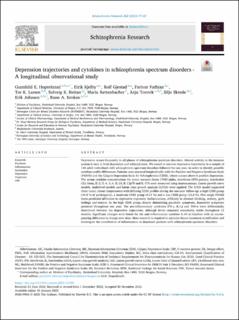| dc.description.abstract | Depression occurs frequently in all phases of schizophrenia spectrum disorders. Altered activity in the immune system is seen in both depression and schizophrenia. We aimed to uncover depressive trajectories in a sample of 144 adult individuals with schizophrenia spectrum disorders followed for one year, in order to identify possible cytokine profile differences. Patients were assessed longitudinally with the Positive and Negative Syndrome Scale (PANSS) and the Calgary Depression Scale for Schizophrenia (CDSS), where a score above 6 predicts depression. The serum cytokine concentrations for tumor necrosis factor (TNF)-alpha, interferon (IFN)-gamma, interleukin (IL)-1beta, IL-2, IL-4, IL-6, IL-10, IL-12p70 and IL-17A were measured using immunoassays. Latent growth curve models, multilevel models and latent class growth analysis (LCGA) were applied. The LCGA model supported three latent classes (trajectories) with differing CDSS profiles during the one-year follow-up: a high CDSS group (40.8 % of participants), a moderate CDSS group (43.9 %) and a low CDSS group (15.3 %). Five single PANSS items predicted affiliation to depressive trajectory: hallucinations, difficulty in abstract thinking, anxiety, guilt feelings and tension. In the high CDSS group, despite diminishing psychotic symptoms, depressive symptoms persisted throughout one year. The pro-inflammatory cytokines IFN-γ, IL-1β and TNF-α were differentially distributed between the depressive trajectories, although levels remained remarkably stable throughout 12 months. Significant changes were found for the anti-inflammatory cytokine IL-10 at baseline with an accompanying difference in change over time. More research is required to optimize future treatment stratification and investigate the contribution of inflammation in depressed patients with schizophrenia spectrum disorders. | en_US |

